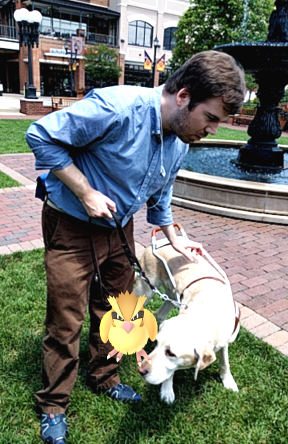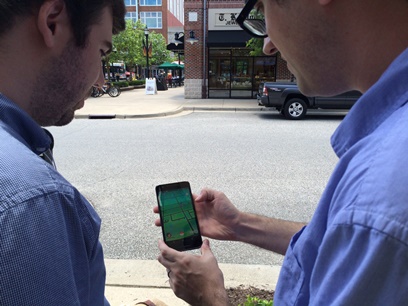By William Reuschel and Aaron Preece
Image: Aaron Preece stands with his guide dog Joel and a Pidgey Pokémon.
Pokémon mania is sweeping the nation once again! The latest incarnation of the game that has players collecting and battling fictional creatures is called “Pokémon GO,” but this version is a little different from past games. You can’t play GO on your couch. In fact, you’ll have a hard time playing it indoors at all. Pokémon GO is all about getting players outside and interacting with various points of interest around their towns. Communities everywhere are buzzing with activity as people battle for control of “gyms” located near parks, churches, statues, and businesses.
We wanted to take a moment to consider the unprecedented opportunity that Nintendo and the app developer, Niantic, have to provide equal access to the social phenomenon they have created. With just a little bit of extra effort, Pokémon GO could be made completely accessible to people with vision loss. A game with such profound social significance that allows for inclusion of all people who wish to play it could have significant and meaningful impact on the lives of gamers who are blind or visually impaired.
Image: Aaron Preece and William Reuschel play Pokémon GO.
The GameIf you haven’t heard about the specifics of this game, let’s hit the highlights. In the game, you are a Pokémon trainer with the goal of collecting as many different kinds of Pokémon as you can. You accomplish this by walking around your town and visiting virtual “Poké Stops,” which are usually points of interest like statues or fountains, and stocking up on in-game supplies like Poké Balls. As you walk around, you will encounter the Pokémon themselves. You throw Poké Balls at Pokémon to catch them.
Once you catch enough Pokémon, you are invited to join one of three teams. Now you have access to the last major feature of the game, which is battling with your team for control of Pokémon Gyms. Gyms are distributed among the points of interest around town, and everyone in the immediate area of the Gym can compete on behalf of their team to maintain control of them.
The FixesWe have presented a simplified explanation of the game itself, but it should be clear that the actual gameplay mechanics are significantly different from the more traditional experience that one might have when playing an action game on a console in their living room. Most modern video games are highly visual, with the entire gameplay based on sights, sounds, and your reaction time to them. It is extremely difficult, if not impossible, to make action or sports video games, for example, accessible to someone who can’t see the screen without making fundamental changes to the way they’re played. The gameplay in Pokémon GO does have visual aspects, but there’s much more strategic depth to the gameplay centered on physically going to places and interacting with an augmented reality of the virtual world overlaid on the physical world. This makes it a great candidate for game accessibility.
The good news is that it wouldn’t be difficult for Nintendo to make the game accessible to people who are blind or visually impaired. Pokémon Go already makes great usage of haptic or touch-based feedback and sound cues. Only minor changes are necessary to include blind and visually impaired gamers. Here are some of the accessibility challenges of the game, and how we propose they be addressed in future versions:
Challenge: Reading and Accessing the Visual Menu System
Currently, the menus in the game must be visually read, but making menus accessible is easy. VoiceOver, TalkBack, or an in-game speech engine could be used to vocalize the text of the menus and other on-screen text.
Challenge: Using the Visual Map
When you open the game, there is a visual of your avatar on a stylized map of the actual roads and buildings nearby. As you move, so does your avatar. The map is helpful because it shows the location of Poké Stops and Gyms. To be accessible, simply having a spoken list of the points of interest nearby, with their distance and actual address, would allow anyone with the appropriate orientation and mobility skills to navigate to them.
Challenge: Visiting a Poké Stop Location
When you get to a Poké Stop, you have to spin a disc and collect some items that appear by swiping over them. This can be done with auditory cues in the game right now, but there’s an accessory in the works that will make this even easier. The “Pokémon GO Plus” is a wearable device that buzzes and flashes a light when you’re near a Poké Stop. You will just press the button on it to collect the items.
Challenge: Catching Pokémon by Throwing a Visual Poké Ball
This game mechanism will require some work. As it exists today, to catch a Pokémon, you have to find it and accurately fling a Poké Ball at it to catch it. To be accessible, this part of the game could be enhanced with audio cues to let you know where the Pokémon is and whether or not you’ve aimed the Poké ball properly. Niantic says that the upcoming Pokémon GO Plus accessory can be used to notify users of Pokémon in the area, and even automatically catch them for you (if you’ve already caught one of that type). Flinging the Poké Ball is a very small aspect of the game, and some sort of accessible alternative could be devised easily without degrading the quality of the experience.
Challenge: Battling in a Gym
A gym battle is a frenzied series of taps and swipes to try to reduce the opponent Pokémon’s health to zero to knock it out before it has a chance to do the same to yours. A Gym battle is less about how effectively you can tap and swipe, and more about how well you’ve prepared your Pokémon before the battle. An accessible alternative, such as sound enhancements, could be devised.
Wrap upPokémon GO is irrationally fun. Nintendo has tapped into our innate desire to collect rare things and compete with each other. With a few simple enhancements to the game, this international phenomenon could be inclusive in ways never before possible, and even people with no visual access to the screen could engage with other players on a level playing field. Pokémon GO is leading the way to a new form of reality and virtual gaming, and this is an opportunity to be sure that gamers who are blind or visually impaired are included in its evolution from the very beginning.
Editor's note: AccessWorld editor Lee Huffman explored this topic further in Pokémon GO: Elevating the Conversation around Accessible Gaming.

